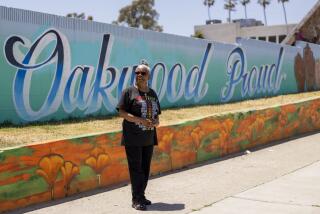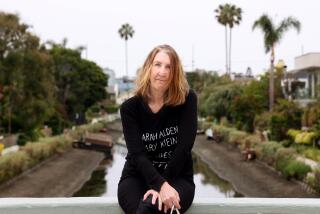A Tenuous Truce : Gang Cease-Fire in Violence-Plagued Oakwood Kept Summer Peaceful; Police Remain Skeptical
One year after the start of a bloody war between black and Latino gangs, a tenuous cease-fire has brought relative calm to the troubled Oakwood neighborhood of Venice.
Social workers are applauding the unofficial truce reached last summer by the community’s two major gangs, whose feud has claimed at least 17 lives since last September. Officials say Oakwood--a low-income, ethnically diverse enclave of quaint bungalows less than a mile from the beach--has seen no gang shootings since mid-June, when the truce took effect.
“Everything’s cool, and it’s gonna stay that way,” said Jimmie Powell, a counselor for Project Heavy West, a nonprofit gang diversion program, who was wounded in an Oakwood shooting in January during the height of the war.
Bud Jacobs, principal of Venice High School, said the truce appears to be sticking. “You can feel tension if it exists, but for the first two weeks of this semester, it’s been calm and almost amiable,” he said.
Powell and others who work with youths said the gangs have continued talks and even plan to deliver a list of suggested community improvements to elected officials such as Los Angeles City Councilwoman Ruth Galanter.
Although some sources have said continued battles over drug-selling turf threaten the peace, jittery neighbors are hoping for the best. During the darkest days of the gang war, some fearful adults kept their children indoors and carried guns for self-protection while on routine errands. The sound of nearby automatic weapon fire became commonplace.
“People just got tired of all the killing,” said Raphael Anderson, 34, a lifelong resident of Oakwood. “Wherever you walked, you had to look over your shoulder. It was like a Bosnian war situation around here.”
Police have taken a more skeptical attitude toward the truce. Lt. John Weaver of the Los Angeles Police Department’s anti-gang CRASH unit said gang members may have called a temporary cease-fire because the violence was leading to increased police patrols, which in turn were interfering with drug sales.
Members of the mostly black Shoreline Crips and mostly Latino Venice-13s, or V-13s, have steadfastly refused comment, but Brad Carson, a Los Angeles County probation officer who helped negotiate the truce, said community pressure and sheer fatigue had prompted gang members to seek a brokered cease-fire.
Gang members “wanted to stop it themselves. They just didn’t want to be the first ones to make the move,” Carson said. “They just had a definite lack of communication.”
The war erupted a year ago, after a Latino man affiliated with the V-13s was shot by a black assailant, according to Mike Duarte, deputy district attorney in Santa Monica.
That shooting apparently had nothing to do with gangs. But it served to inflame racial tensions in the community, which was once predominantly black but is now about half Latino.
A series of grim, tit-for-tat reprisals ensued. Some of the attacks were directed not at rival gang members, residents say, but at bystanders evidently targeted because of their race.
Carson said gang members agreed to meet three days after a highly publicized June 10 double murder not far from Oakwood. Two Latino teen-agers, neither of whom was believed to be a gang member, were slain in a drive-by attack as they sat in a car on Venice Boulevard.
Carson said he and another probation officer took leaders of the opposing gang factions to a neutral site in South-Central Los Angeles, where they discussed their differences. Soon rival gang members could be seen playing baseball together in neighborhood parks.
Social workers also helped arrange meetings between gang leaders and Galanter, who later reported that the youths had raised concerns over a lack of jobs, dearth of recreational facilities and perceived police hostility in their community.
“I’m willing to (pursue) whatever (program) somebody can come up with, if they can explain how it will make the situation better and get people jobs,” Galanter said.
Many say the fate of the cease-fire ultimately depends on giving youths alternatives to gangs. Pearl White, a longtime Oakwood activist who runs a drama program aimed at youngsters, sees a window of opportunity in the armistice.
“If we can put positive things before young people, there’ll be a turnaround” in the gang violence, she predicted.
“The job is not finished until we see what we can do about the situation that caused the problem in the first place,” said Bill Martinez, executive director of Community Youth Gang Services in Los Angeles. “These young people are really behind the eight ball when it comes to getting jobs.”
More to Read
Sign up for Essential California
The most important California stories and recommendations in your inbox every morning.
You may occasionally receive promotional content from the Los Angeles Times.











